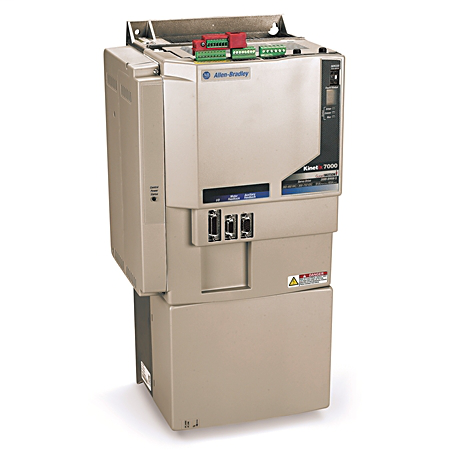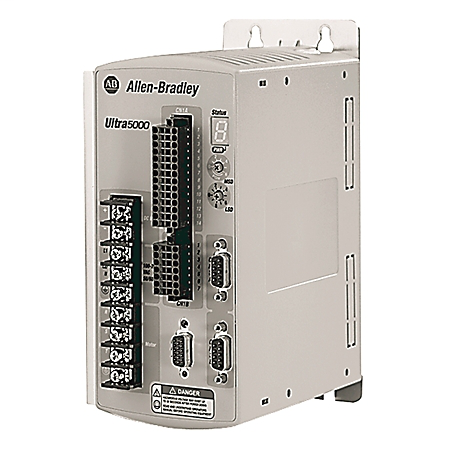Servo Drives
Servo Drives, essential components in various systems, address deviations in a hydraulic, pneumatic or electric actuator’s performance caused by external forces. These drives utilize feedback sensors and intelligent controllers to fine-tune the actuator’s operation during runtime.
Servo systems aren’t typically all-in-one — they’re made up of multiple components with distinct functions. Familiarity with different parts, like servo drives that send energy to the motor, is important when diagnosing the problem with a system or selecting the right tech for a new machine.
-
 ALLEN BRADLEY
ALLEN BRADLEYALLEN BRADLEY 20BD011A3AYNAED1 Drives Repair Maintenance and Troubleshooting Service — Replacement Parts Sales
- Model #:
- 20BD011A3AYNAED1
- Part #:
- 20BD011A3AYNAED1
-
 Allen Bradley
Allen BradleyAllen Bradley Architecture Class Drives, PowerFlex 70, Model 20AD065A0AYNANC0 | Repair Service, Sales
- Model #:
- 20AD065A0AYNANC0
- Part #:
- 20AD065A0AYNANC0
- New/Surplus $ 12065
- Refurb. Price $9652 Save up to $ 2413
- Repair Price $6031 Save up to $ 6034
-
 Allen Bradley
Allen BradleyAllen Bradley Servo Drives, Kinetix Drives, Model 2099-BM10-S | Repair Service, Sales
- Model #:
- 2099-BM10-S
- Part #:
- 2099-BM10-S
- New/Surplus $ 22335
- Refurb. Price $17868 Save up to $ 4467
- Repair Price $11166 Save up to $ 11169
-
 Allen Bradley
Allen BradleyAllen Bradley Servo Drives, Kinetix Drives, Model 2099-BM08-S | Repair Service, Sales
- Model #:
- 2099-BM08-S
- Part #:
- 2099-BM08-S
- New/Surplus $ 14711
- Refurb. Price $11768 Save up to $ 2943
- Repair Price $7354 Save up to $ 7357
-
 Allen Bradley
Allen BradleyAllen Bradley Servo Drives, Kinetix Drives, Model 2099-BM09-S | Repair Service, Sales
- Model #:
- 2099-BM09-S
- Part #:
- 2099-BM09-S
- New/Surplus $ 16851
- Refurb. Price $13480 Save up to $ 3371
- Repair Price $8424 Save up to $ 8427
-
 Allen Bradley
Allen BradleyAllen Bradley Servo Drives, Ultra Drives, Model 2098-DSD-HV150-SE | Repair Service, Sales
- Model #:
- 2098-DSD-HV150-SE
- Part #:
- 2098-DSD-HV150-SE
- New/Surplus $ 7149
- Refurb. Price $5719 Save up to $ 1430
- Repair Price $3573 Save up to $ 3576

What Is a Servo Drive?
Servo drives or amplifiers are components that systems use to power electric servomechanisms, or servos, which use error-sensing to correct the function of an actuator. The motion controller manages both the movement of an actuator and the error-correction process. To do this, it collects relevant information on actuator function from a feedback sensing device — typically resolvers, encoders or Hall-effect devices — and determines how the motor needs to behave to adjust the actuator’s function.
The servo controller then tells the drive how much voltage and current to send to the motor to adjust the actuator output as needed.
By adjusting the amount of power being driven to the actuator, the servo drive can correct for operational variables like speed, torque and position.
Variations and Servo Drive Features
There are many types of servo drives with different features, including brushless drives for BL servo motors and various sizes depending on the space you have available.
Both single-axis and multi-axis drives for servo motors are available, but single-axis drives are more common. While multi-axis drives can deliver power to motors that control multiple actuator axes, single-axis drives remain popular. These drives are typically used when there are only a few axes in a system, or when each of those axes needs a significant amount of power — typically, larger than 15 kW for individual axes.
Most drives are also configured to work with a motor of the same brand.
The Difference Between a Servo Drive and Motion Controller
Servo systems and motion controllers both work together to adjust the movement of an actuator. They don’t perform the same work, however.
A motion controller controls the output of the actuator by adjusting how much power the servo amplifier sends to the motor in order for the actuator to move in the desired fashion — whether that means adjusting for speed, position or angular rotation.
Typically, a controller provides one of two main functions — setpoint tracking, also known as reference or command tracking, or disturbance rejection.
Setpoint tracking makes sure the actuator’s movements line up with the expected output. A command-tracking controller calculates deviation and signals the servo motor to adjust speed based on how the actuator should be performing.
Disturbance rejection, by contrast, monitors for outside sources, also called disturbances or “loads,” that change the function of the actuator — like vibrations from other systems, changes in pressure or resistance against actuator movement. The controller then determines how the servo system can move to correct for this disturbance, balancing it out and returning the actuator to roughly the movement needed.
If the motion controller detects deviation with the system’s feedback-sensing device, it sends information to the servo drive, telling it the amount of energy to send to the motor to correct that actuator’s movement.
Typically a feedback controller will only be responsible for either setpoint tracking or disturbance rejection.
While amplifiers and controllers are separate components, they may sometimes be sold together as servo controllers. These provide the same functionality as the separate parts but bundled into one enclosure.
Common Problems With Servo Drives
Like any piece of industrial equipment, servo drives and systems will need repairs or replacement after time.
Often, with the right knowledge, you can troubleshoot and resolve many common problems that servo drives and motors face over their lifespan.
1. Overheating, Smoke or a Burning Odor
Servo drives can be susceptible to overheating, especially in hotter summer months.
Temperature sensors can tell you if a drive is overheating. You may also get a warning sign in the form of a burning odor or a “funny smell” around the servo system.
Unexpected smoke is generally a reliable sign that something has gone wrong. If an electronic component or drive lets out any “magic smoke” when activated, it may indicate that internal electronics are burning due to an overload or short circuit.
If you think the drive is overheating, turning it off and inspecting the cooling system is a good place to start. Insufficient air flow or clogged filter in a cooling system can cause system components to overheat, including the drive. If your servo isn’t enclosed, you can check the drive for dust or dirt particles that may clog the drive and cause it to overheat.
Overheating can also be caused by old equipment — in these cases, replacing the drive may be the best option.
While air flow is good for a servo drive, opening the enclosure or cabinet door to expose the servo drive isn’t a good idea. This is more likely to let in dust and dirt in the air, especially when in combination with an external box or industrial fan.
2. Erratic Movement or Reduced Torque
Unexpected adjustments to the actuator’s movement — or reduced torque in the actuator due to servo motor malfunction — may be a sign that something is wrong with the servo drive.
If a drive receives low voltage from the system, it can’t drive the right amount of power to the motor. Damaged, open or incorrect system wiring can also impair drive performance.
Reduced torque may also mean that the desired motor inertia may be beyond the capacity of the amplifier you have installed.
3. No Response to Controller Commands
If the drive doesn’t respond at all to controller signals, it could be a sign of a more serious problem — or faulty connections between different components in the servo and actuator system.
It’s also possible that one or more wires attached to the drive are open, damaged or otherwise faulty. There may be a failure in the controller, and the controller’s Digital-Analog-Converter output may be incorrect. If you find the value of your controller’s DAC parameter is at or around zero, it may mean the controller needs to be replaced. Higher values, on the other hand, may signal correct function and a problem with another component in the system.
Contact Global Electronic Services for Repairs or to Buy Servo Drives
Whether you need servo drive repairs or want to buy servo drives, Global Electronic Services can help. Our technicians and sales staff have years of experience and the expertise to solve your problem or find the right driver for your equipment.
If you’re interested in working with us, call today at 877-249-1701, or request a quote today to get in touch.

